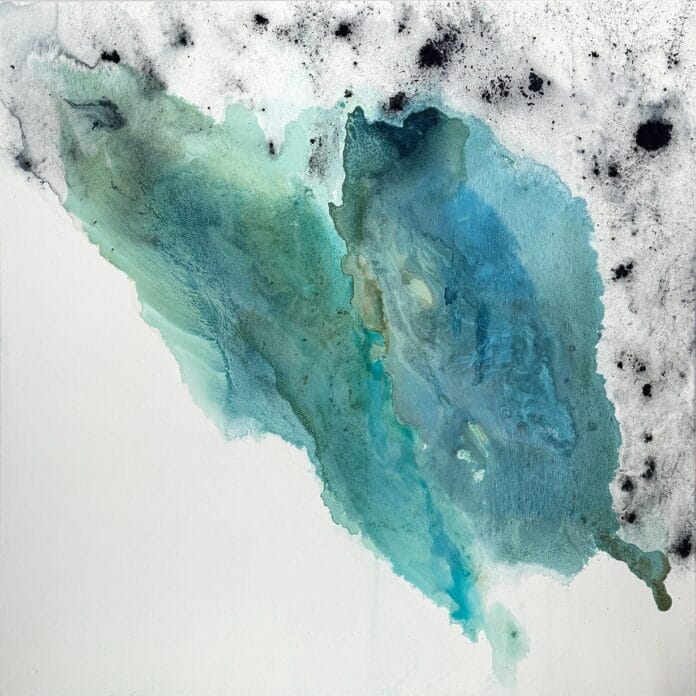Catalina Christensen is a London-based Colombian artist and pigment-maker whose work bridges the poetic and the elemental. Deeply influenced by her travels and experiences in nature, Catalina’s practice does not aim to replicate what she sees. Instead, she distills the atmosphere, energy, and memory of landscapes into luminous, abstract compositions that feel both intimate and expansive. Her work speaks in a visual language formed not just from color and composition, but from the very earth itself—literally ground into pigment.
The Essence Over the Image
Christensen’s paintings do not offer viewers a literal depiction of a place. Instead, they invite them into the feeling of being there—the hush of glacial silence, the hum of unseen movement beneath the soil, or the scent of rain on mineral earth. Her canvases are deeply atmospheric, often built from translucent layers that echo the passage of time and nature’s quiet rhythms. This shift from representation to sensation reflects a personal, immersive way of seeing the world—one where memory, mood, and matter merge.
Material as Message: From Oil to Egg Tempera
What sets Catalina apart is not only her approach to subject but her devotion to material. Her early practice in oil painting gradually gave way to egg tempera—a medium rooted in ancient traditions but reinvigorated in her hands. This transition marked more than a technical shift; it embodied a philosophical one. Egg tempera, with its fast-drying nature and luminous finish, demands patience and precision, encouraging a slower, more intentional rhythm in the studio. It also aligns with Catalina’s broader commitment to sustainable art-making.
Her paints are not store-bought but self-made, often from pigments she harvests herself in places that hold emotional resonance. Whether it’s a hillside in Colombia or a rock formation discovered during her travels, these sites are collected not just in memory, but in material. The very dust of the landscape becomes part of her palette. It’s a practice that bridges painting, ecology, and ritual.
Alchemy and Ecology
Catalina’s work is inherently experimental. She blends natural pigments with metal powders, salt, and other materials, catalyzing unexpected reactions and surface textures. These chemical interventions introduce a degree of unpredictability into her process, transforming each painting into a collaboration between artist and environment.
This creative alchemy reflects a profound ecological sensitivity. Rather than exploiting nature for aesthetics, Catalina works in dialogue with it. Each painting is a site of transformation—both materially and metaphorically. Her use of plant-based binders, handmade tools, and biodegradable processes underscores a respect for the Earth that runs through every level of her practice. Her studio becomes a lab for sustainability, intuition, and transformation.
Artwork Spotlight: “Crystalline Undercurrent”
In Crystalline Undercurrent, one of the defining works from her Earth Colours & Textures series, Catalina takes viewers below the surface—literally and emotionally. Inspired by the quiet movement beneath glacial ice, the painting evokes a submerged, fragile world. Through layers of mineral-based blues and silvery greens, she builds a sense of depth and flow that seems to hover between stillness and motion.
The piece was created using natural pigments and a controlled chemical process that allows subtle iridescence and textural shifts to emerge organically. These marks are not decorative—they mirror the Earth’s own slow transformations. The painting invites the viewer to reflect on climate change and the unseen processes shaping our planet. Beneath its quiet surface lies a powerful reminder of what is easily overlooked or taken for granted: nature’s hidden strength and its vulnerability.
Art as Ecological Witness
Catalina’s work is especially timely in an age of environmental precarity. Without being didactic, her paintings serve as meditative spaces for ecological reflection. They draw our attention not just to what is seen, but to what lies beneath and beyond. Her choice to physically integrate natural elements into her work reinforces the interconnectedness of human life and landscape.
By making pigment from place, she memorializes it. By allowing natural processes to guide the outcome of her work, she honors unpredictability. In Catalina’s art, nature is not just a subject—it is a collaborator, a co-creator, and at times, even the lead voice.
Conclusion: A Quiet Power
Catalina Christensen’s practice is a reminder that art can be an act of reverence. Her paintings, quietly powerful and materially rich, ask us to slow down, pay attention, and engage with the world more deeply. Through her synthesis of memory, material, and landscape, she offers not just images but experiences—ones that linger long after we’ve stepped away from the canvas.
In a world increasingly dominated by speed and spectacle, Catalina’s work offers a gentle resistance: a return to earth, to process, and to presence.


